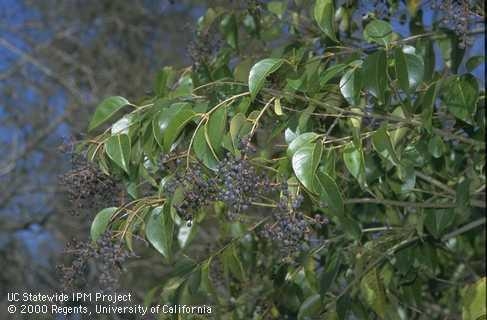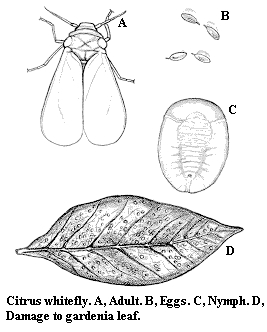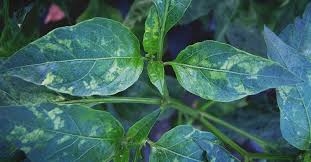Plant viruses are very tiny unliving particles. In the midst of our current pandemic of COVID19, more accurately SARS-CoV-2, most of us are aware that viruses are minute packets of RNA (or DNA) surrounded by a protein capsid, but what some of us may not know is that the first virus to be studied, named, and understood was a plant virus called Tobacco Mosaic.
Disease: Tobacco Mosaic Virus
In the 1890s Tobacco Mosaic caused major economic problems for tobacco growers, who often lost 80% of their affected crop and many biologists were encouraged to study it. Dutch plant pathologist, Adolph Mayer, who named this disease in 1879, was unable to culture the disease or identify the pathogen. In 1887, Crimean botanist Dmitri Ivanovski tried filtering tobacco mosaic disease from the sap, known by then to spread the disease to any tobacco leaf it touched. He could not find any pathogen particle filtered out and concluded that the fluid contained a toxin that caused Tobacco Mosaic. In 1898, Dutch microbiologist Beijerinck published this shocking new theory: the disease was caused by contagious poison liquid, which he called virus, from the Latin for liquid poison.
Although Foot-and-mouth disease of cattle, caused by a filterable agent was discovered the same year, 1898, and the agent for yellow fever in Cuba, was found to be filterable in 1901, researchers didn't consider the animal pathogens related to the plant virus. It wasn't until the mid-1930s that tobacco mosaic virus had been crystallized and x-rayed to show that it was a solid particle.
Your plants may have viruses if the leaves form mosaic patterns, turning yellow. It's best to know which virus, because many viruses are spread by insect vectors such as leaf hoppers or aphids (you can remove these right away with insecticidal soap); others by tools, so you need to bleach your pruning tools, gloves, and even hoses; and sadly, some are spread by pollen. There is no cure for plants already infected with a virus; you need to remove them and then sterilize your gloves and tools.
But just as we have developed vaccines for human viruses, botanists have developed virus resistant stock. Buy these at the nursery and enjoy a virus-free garden while we work to control this new human virus.
For more info, visit the UC IPM website.
Weed: Invasive Privet
This issue's weed is a weed tree or bush, the invasive Privet. Its scientific name, Ligustrum vulgare, gives the impression that it is vulgar and unwanted. Unfortunately, quite a few gardeners don't understand all the problems that this tree's berries cause. The shiny black berries do produce a good source of food for birds, but the birds spread this weed tree readily in their excrement. The berries grow quickly and numerously into what can become a thicket, out competing desirable plants. They will sprout just about anywhere, even deeply hidden in hedges. Many people harbor this plant thinking it is a camellia or other waxy leaved desirable plant. Mow and blow services simply clip off the tops so that they are temporarily unnoticeable. This only adds to the problem by allowing them to grow stronger root systems which will necessitate digging them out or painting the stumps with concentrated herbicide. Once established, they are very resistant to herbicidal spray control. The original saplings can be easily pulled out by hand if they haven't gotten too tall. If this plant or its saplings are in your landscape, please do your neighborhood a favor and remove them.
For more info, visit the UC IPM website.
For more info, visit the CAL IPC website.
Pest: Citrus Whitefly
This pest is a relatively new problem in California but has become very common in some neighborhoods. Citrus Whitefly, Dialeurodes citri, is one of several whiteflies that can infest citrus, but unlike some of the others, this one's high populations and the honeydew it emits can cause significant problem. Beyond sucking on the sap of the citrus tree, the honeydew allows a thick growth of black sooty mold which blocks the availability of light to the leaves and leaves a very undesirable stain on the fruit. One of the life stages of this whitefly is a scale like stage which could easily mislead you into thinking it is a separate pest. The first UC-IPM reference below is for commercial fruit growers. Unfortunately, we do not have a homeowner pest note yet specifically dedicated to this pest. The second reference is on control of whiteflies in general and mentions one that is organically certified, Neem Oil. Other alternatives are to harbor natural controls for this pest and even to vacuum them up as they fly once disturbed. Like most other honeydew producing pests, ants usually accompany them and protect them, so control of the ants will help the control of the whitefly. If you do decide to control with pesticides, keep in mind that while citrus trees are in bloom, they attract numerous bees which can be unintentionally harmed.
For more info, visit the UC IPM website.


